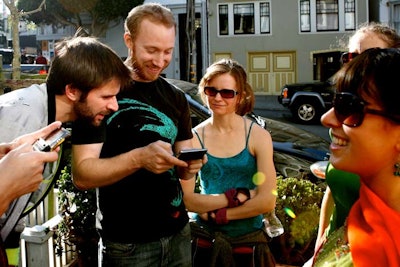
Social media platforms and apps are adding gaming elements like badges, channels, and leader boards to the daily lives of many smartphone users. As a result, teambuilding companies are seeing a rise in requests for activities that bridge the digital and the physical.
“Everyone loves gadgets, and they want to be a part of what’s new and cutting-edge,” says Lisa Jennings, chief experience officer at Wildly Different, an Orlando-based teambuilding company that launched an iPad hunt in September involving a custom mobile app that delivers directions and clues.
“Teambuilding has always involved basic game mechanics,” says Russell Brumfield, C.E.O. of Wizard Studios Global Events, whose company launched an event technology division in 2009. “The difference is that now people are adding a technology layer, which allows for more of a learning takeaway on top of the physical bonding.” Wizard’s teambuilding games deliver missions and track scores via a custom app, but also integrate physical challenges and real-world interactions. For a Johnson & Johnson meeting last year, “we created an activity that had employees interacting with character actors and filming funny videos, but that also involved the employees solving informational challenges about new products on their phones,” Brumfield says.
The new tools can even help motivate especially jaded employees. “The technology element definitely helps ease people into the game and makes teambuilding seem less gimmicky,” says Ian Fraser, co-founder of tech enabled-scavenger-hunt company the Go Game, which has worked with Google, Apple, Facebook, Microsoft, and Intuit. Fraser adds that using smartphones and tablets has logistical advantages, too, particularly with large groups. “Having the points tabulated on a cloud-based system makes the process much faster—there’s no need to have someone with a pen and a calculator,” Fraser says.
Adds Brumfield, “Phones and iPads make it much easier to talk to a thousand-person group and make something happen instantaneously, since everyone is looking at the same portal.”
The latest element in high-tech co-worker bonding is all-virtual teambuilding game platforms. After getting requests from clients who wanted to continue the company bonding beyond a one-day event, Fraser and his team launched the Go Game Office. The online software, which costs $100 a month for as many as 100 players, involves dividing employees into teams that get new mini missions every week, like sharing your favorite lunch spot, or posting your most awkward childhood photo for points. More than 500 companies have signed up since the Go Game Office launched in 2010. “The idea was to create a private, Facebook-y environment that built on employees’ intrinsic need to engage with each other, but that only took five minutes a week,” Fraser says. “The main goal is getting to know your co-workers. It’s about connecting with people.”
Other companies are looking beyond simply connecting co-workers on an entertainment level in the virtual world, hoping to increase engagement and productivity among employees by adding gaming elements to intranet platforms. Social business-software platform Jive teamed with game-mechanics service provider Bunchball in March to launch the Jive Gamification module. The software incorporates role-based missions, challenges, status levels, and badges into digital education and training experiences. A company’s sales staff, for example, could take part in a competition to see who could complete training materials first. “It’s about creating a fun environment at the workplace,” says Bunchball sales representative Angelina Elhassan. “Ropes courses and other teambuilding activities offer a way to get to know your coworkers outside of the office. This is meant to function as a way to encourage daily bonding.”
Experts emphasize, however, that these new virtual teambuilding platforms are meant to augment face-to-face bonding, not replace it. “I think the future of teambuilding is hybrid—nine months of virtual bonding and then coming together [a few times a year] for physical bonding,” Brumfield says. “It’s like Facebook, in which people are keeping in touch with each other [even] when not physically in contact. All this technology is bringing people closer together, and the game layer is adding to the motivation for participation.”
Adds Fraser, “[A team] can virtually sail a boat together and say, ‘We’ve achieved an eye-patch badge and 10 gold coins,’ or they can actually learn to sail a boat together and feel the saltwater splash in their faces. I think there will always be a place for hands-on activities, even if technology is involved.”



















